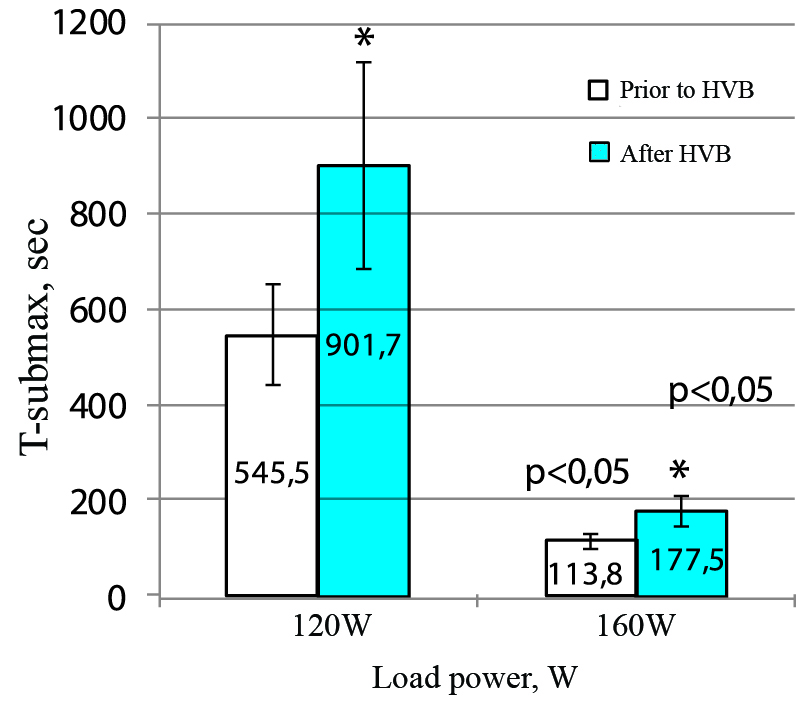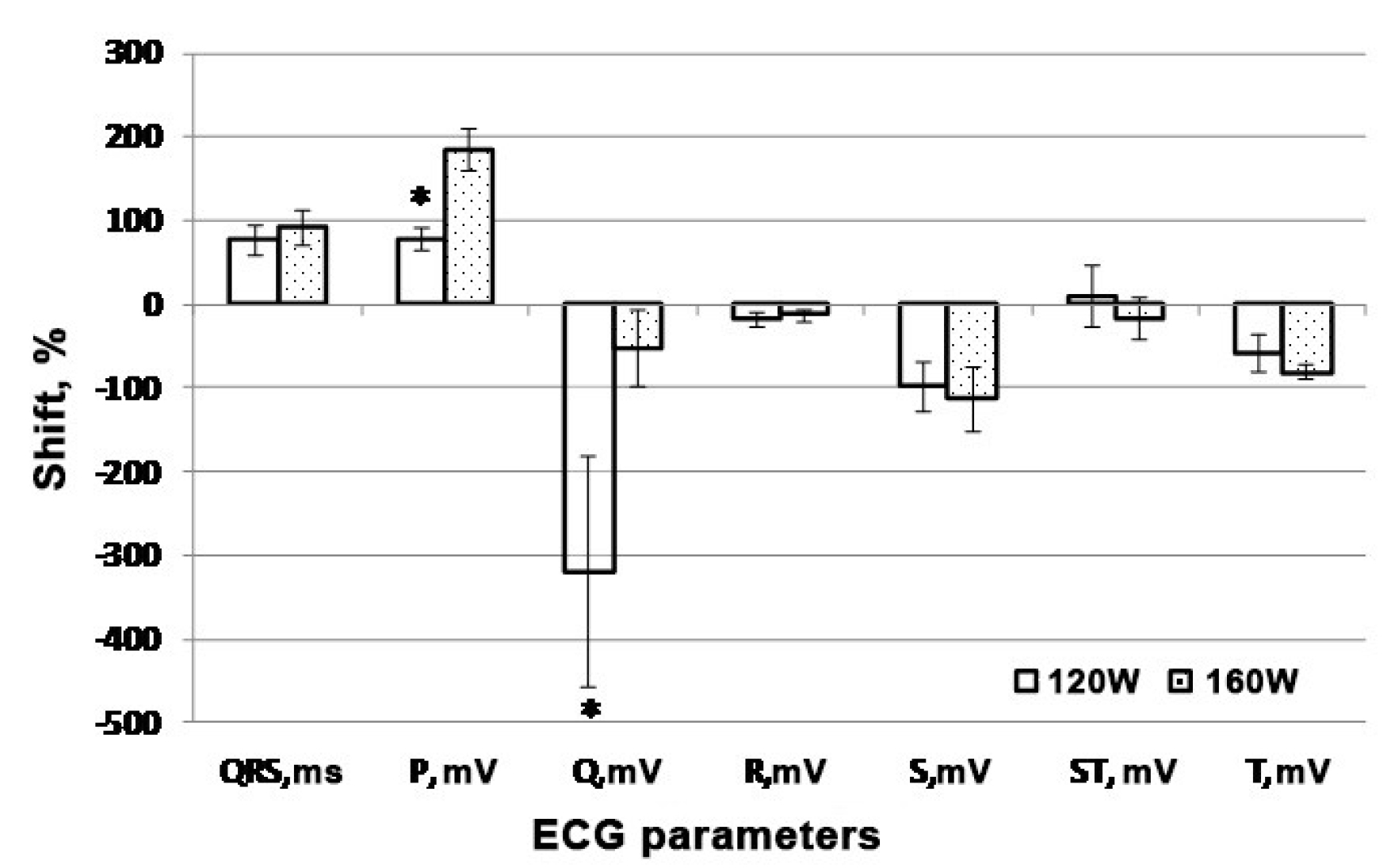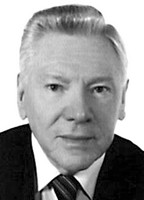Effects of hypoventilation breathing on physical working capacity and cardiorespiratory rates of under step exercises: comparative analysis
Фотографии:
ˑ:
Corresponding member of RAS, Dr.Biol., Professor N.A. Fudin1
PhD S.Ya. Klassina1
PhD S.N. Pigareva1
Dr,Med., Professor Y.E. Vagin2
1P.K. Anokhin Research Institute of Normal Physiology, Moscow
2I.M. Sechenov First Moscow State Medical University, Moscow
Keywords: sports, submaximal exercise, hypoventilation, physical working capacity, functional state.
Introduction. Athlete’s functional state and physical working capacity depend not only on his age and fitness level, but also on the intensity of physical workload. It was demonstrated that hypoventilation breathing, being developed during pedaling exercises on a bicycle ergometer performed in the moderate power zone, changes the athlete’s functional state and contributes to the improvement of his physical working capacity rates [1]. Yet, will this effect last if we increase the load power?
Objective of the study was to analyse the effects of hypoventilation breathing on man’s physical working capacity and duration of submaximal exercise under physical loads of various intensity.
Methods and structure of the study. Subject to the study were 14 apparently healthy males aged 18-24 years, regularly practicing physical culture. Each testee was examined 4 times: twice before and twice after the hypoventilation breathing training (HBT), during which he was asked to perform submaximal physical work on a bicycle ergometer. The surveys were identical and differed only in the level of power of load testing: 120W or 160W. In-between the 2nd and the 3rd tests, the subjects were trained to apply hyperventilation breathing for 30 days according to the following pattern: inhalation - 1.2 sec, expiration - 1.5 sec, pause - 7-10 sec [1]. During the examination, the subjects were in the following functional states: "background" (2.5 min); "warm-up - 60W" (2 min); "exercise stress test" at the constant cadence of 1 rps; "recovery" (6 min). The load testing duration was determined by the moment the subject reached the submaximal level of load (T-submax, sec). The exercise stress test was conducted using the bicycle ergometer Sports Art 5005. The electrocardiography (ECG) and pneumogram-guided test was carried out by means of the digital ECG system Poly-Spectrum-8 (Neurosoft, Russia). The following parameters were estimated: heart rate (HR, bpm), respiratory rate (RR, 1/min), ECG waves (P, Q, R, S, T) and segments (QRS, ST) [7, 8], and timed inspiratory capacity in the background and after exercise. The statistical processing was made using the non-parametric test. The significance of differences of the cognominal indicators was estimated using the Wilcoxon test.
Results and discussion. We conducted a comparative analysis of the time of submaximal training at the 120W and 160W loads. Figure 1 illustrates the mean time of submaximal training (T-submax, sec) at the 120W and 160W loads before and after the HVB training.

Fig.1. Mean time of submaximal training (T-submax, sec) at the 120W and 160W loads up prior to (white bars) and after (patterned bars) the HVB training.
Legend: * - p<0.05 - significance of difference in the T-submax index for the same load power prior and after the HVB training; p<0.05 - significance of difference in the T-submax index at the 120W and 160W loads prior to and after the HVB training.
It can be seen that when working at the same load power, the T-submax index after the HVD training increases significantly, whilst at the 120W load it ranges from 545.5±104.8 to 901.7±216.6 sec (p<0.05), 160W load - from 113.8±17.1 to 177.5±32.0 sec (p<0.05). At the same time, the relative shift of the T-submax index equaled 65% and 56%, respectively. Therefore, HVB contributes to statistically significant improvement of physical working capacity rates under both test loads.
If prior to the HVB training the increase in the load power from 120W to 160W was accompanied by a decrease in the T-submax index from 545.5±104.8 to 113.8±17.1 sec (p<0.05), then after the HVB training it amounted to 901.7±216.6 to 177.5±32.0 sec (p<0.05). Hence, the higher is the physical load intensity the shorter is the submaximal physical exercise. Thus, HVB contributes to significant enhancement of physical working capacity rates in the subjects, but with increasing power of physical load this enhancement will decline.
It is known that the increase of physical load power also leads to the changes in the mechanism of energy exchange. In the latter case, energy is produced in anaerobic conditions, and, consequently, against the background of oxygen debt, the level of lactic and phosphoric acid in the blood increases, blood pH changes, etc., as a result of which an athlete is to reduce the power of work or reach the submaximal level and just stop training. The moment of transition from an aerobic to anaerobic form of energy metabolism is defined as an "anaerobic threshold" - AT [2].
Under intensive physical load, oxygen is delivered to the tissues via the cardiovascular and respiratory systems, the key informative indicators of which are HR and RR. The efficiency of these systems can be determined by external factors, such as voluntary hypoventilation breathing [3]. Let us make a comparative analysis of the HR and RR parameters during submaximal exercise at the 120W and 160W loads prior to and after the HVB training (Table 1).
Table 1. HR and RR at submaximal level with the 120W and 160W loads prior to and after the HVB training, M ± m
|
Load power |
Parameters |
Prior to HVB training |
After HVB training |
|
120 W |
HR, bpm |
161.4 ± 3.6 |
163.8 ± 3.1 |
|
|
RR, 1/min |
28.5 ± 1.7 |
27.5 ± 1.5 |
|
160 W |
HR, bpm |
164.2 ± 4.1 |
167.6 ± 3.9 |
|
|
RR, 1/min |
31.2 ± 1.5 |
31.4 ± 1.7 |
The comparative analysis of the mean HR prior to and after the HVB training (Table 1) suggests for the conclusion on a weak tendency that HR increases after the HVB training at both steps of load testing, which favors the HVB as a means to increase the maximum level of development of physical qualities in the subjects. At the same time, the RR index, on the contrary, had a weak tendency to decrease at the 120W load, but remained practically unchanged at the 160W load. We assume that it was at the moment of submaximal load that the cardiorespiratory system of the subject reached its potential. However, if at the 120W load against the background of HVB the effect of "economization" of breathing takes place, at the 160W load this effect is not observed. Probably, at the 160W step this may be due to a change in the mechanism of energy exchange.
It is known that the aerobic zone of physical load is the most optimal for athletic training, especially when the load intensity is close to the AT. It was demonstrated that in the aerobic zone, the maximum HR, depending on the age of the subject, can be calculated by the formula: HRmax = 180 - age (year) [4]. Since the average age of our subjects was 19.1±0.3 years, the maximum for the aerobic zone HR should be 160.9 bpm. As follows from Table 1, after the HVB training the moment of submaximal 120W and 160W loads occurs right after passing the AT, in the anaerobic zone of energy exchange.
The electrocardiographic examination, carried out during the submaximal exercise, makes it possible to analyse the changes occurring in the functional state of myocardium of the subjects at the moment of submaximal 120W and 160W loads. Given that each of the 4 tests was carried out on separate days, their background values varied. Consequently, to conduct a comparative analysis, it is reasonable to move from absolute to relative values, i.e. to the analysis of the shifts of the ECG parameters. Since we are interested in the effects of HVB on the ECG parameters at the 120W and 160W loads, we will compare these shifts as they reflect the changes in the ECG parameters at the moment of submaximal load after the HVB training course. Figure 2 illustrates these relative shifts.

Fig.2. Shifts of the ECG parameters (%) as opposed to the background values at the moment of submaximal 120W load (white bars) and 160W (patterned bars) after the HVB training.
Legend: * - p<0.05 – significance of differences at the l20W and 160W loads.
As seen in Figure 2, the effects of HPV on the ECG parameters are more pronounced at the 160W load, which is confirmed by the greater shifts. Thus, under the 160W load, as opposed to the 120W load, the shift of the P wave is significantly greater and amounts to 183.9±24.7 versus 77.7±12.8% (p<0.05), which makes it possible to maintain higher excitation of the sinoatrial node, adequate to higher load power. The shift of the T wave was negative, which is indicative of the more pronounced sympathetic effects on the heart [5]. At the 160W load, as opposed to the 120W load, the shift of the Q wave was significantly smaller and amounted to -52.7±45.2 versus 319.2±137.2% (p<0.05), which suggests better myocardial oxygen supply [6]. It follows that at the 160W load in terms of submaximal exercise performed against the background of HVB,HR will be higher, and myocardial oxygen supply will be better. We believe that hypoxia, being a powerful vasodilator for coronary vessels, contributes to an increase in the coronary blood flow with increasing physical load, which results in the myocardial oxygen supply deficit reduction.
The subjects’ hypoxia tolerance can be estimated by their timed inspiratory capacity rates. After the HVB training, at the same load power, the mean timed inspiratory capacity values increased statistically significantly: at the 120W load - from 56±5 to 106±8 sec (p<0.05); at the 160W load – from 59±8 to 115±8 sec (p<0.05). This implies that the HVB training contributes to a significant increase in the timed inspiratory capacity rates under any load, which indicates hypoxia tolerance improving after the HVB training.
Conclusion. The hypoventilation breathing skills were found to improve the hypoxic tolerance and physical working capacity rates of the subjects under both of the test loads. Submaximal level of load was normally reached immediately after passing the anaerobic threshold. In contrast to the 120W physical load, the 160W load was associated with the higher excitation of the sinoatrial node on the ECG, slower intra-ventricle conductivity, higher levels of sympathetic effects on the heart; and a better oxygen supply to myocardium. The data obtained allow for more effective planning of the hypoventilation breathing training process.
References
- Murashko E.V. Standartnaya elektrokardiografiya v pediatricheskoy praktike [Standard electrocardiography in pediatric practice]. Lechashchiy vrach, 2005, no. 1, pp. 52-57.
- Sudakov K.V., Sinichkin V.V., Khasanov A.A Vegetativnye reaktsii cheloveka pri raznykh rezhimakh teplokholodovykh vozdeystviy v usloviyakh sauny [Human cold- and heat-defense autonomic responses in sauna conditions]. Fiziologiya cheloveka [Human physiology], 1987, vol. 13, no. 1, pp. 113–119.
- Fudin N.A., Klassina S.Y., Vagin Y.E. Gipoventilyatsionnoe dykhanie kak sredstvo povysheniya fizicheskoy rabotosposobnosti cheloveka pri fizicheskoy rabote do otkaza [Effects of hypoventilation breathing on physical working capacity during exercise to failure]. Teoriya i praktika fiz. kultury, 2016, no. 12, pp. 55-57.
- Fudin N.A. Fiziologicheskaya tselesoobraznost proizvolnoy regulyatsii dykhaniya u sportsmenov [Physiological feasibility of voluntary regulation of breathing in athletes]. Teoriya i praktika fiz. kultury, 1983, no. 2, pp. 21-22.
- Yaremchuk E. Beg dlya vsekh. Dostupnaya programma trenirovok [Running for everyone. Accessible training program]. St. Petersburg: Piter publ., 2015, 230 p.
- Wasserman K., McIlroy M.B. Detecting the threshold of anaerobic metabolism in cardiac patients during exercise. Am J Cardiol. 1964; 14: 844–852.
Corresponding author: klassina@mail.ru
Objective of the study was to analyse effects of hypoventilation breathing on the physical working capacity and cardio-respiratory function rates under the 120W and 160W physical loads. Subject to the study were 14 junior volunteers who performed submaximal cycle ergometer exercise. The subjects were trained to apply hyperventilation breathing for 30 days. Prior to and after the training course the following test data were obtained: individual ECG and pneumograms; timed inspiratory capacity; and submaximal physical work times. The hypoventilation breathing skills were found to improve the hypoxic tolerance and physical working capacity rates of the subjects under both of the test loads. Submaximal level of load was normally reached immediately after passing the anaerobic threshold. It was demonstrated that the higher is the physical load intensity the shorter is the submaximal physical work. In contrast to the 120W physical load, the 160W load was associated with the higher excitation of the sinoatrial node on the ECG, slower intra- ventricle conductivity, higher levels of sympathetic effects on the heart; and a better oxygen supply to myocardium.


